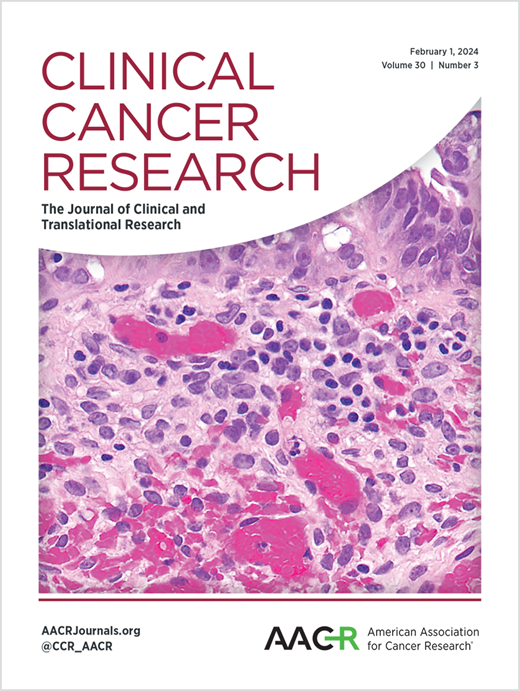ERBB2/HER2 alterations in ctDNA and metachronous tissues of patients with metastatic urothelial cancer.
IF 10
1区 医学
Q1 ONCOLOGY
引用次数: 0
Abstract
PURPOSE HER2 targeting is increasingly relevant in metastatic urothelial cancer (mUC) due to emerging antibody drug conjugates, where assessment of tumor HER2/ERBB2 status could aid interpretation of ongoing trials. We evaluated whether precise ERBB2 genotype can be determined from mUC circulating tumor DNA (ctDNA) and the relationship with tissue status. EXPERIMENTAL DESIGN ERBB2 genotype was determined through targeted sequencing of longitudinal samples from 226 mUC patients. Heterogeneity was evaluated across ctDNA and metachronous tumor tissue ERBB2 genotype and compared to HER2 immunohistochemistry (IHC). RESULTS Activating ERBB2 mutation and/or amplification was identified in 16% and 29% of patients by ctDNA and tissue sequencing, respectively. Alternatively, 55% of tissue samples were HER2 IHC positive. Agreement between HER2 IHC and ERBB2 genotype (by either ctDNA or tissue) was 64%, in contrast to 87% between patient-matched ctDNA and tissue genotypes. Across serial samples, genotype and IHC revealed marked heterogeneity in ERBB2 status. Factors linked with heterogeneity included ERBB2 amplifications on extrachromosomal DNA, detected through whole-genome sequencing of ctDNA and fluorescence in-situ hybridization, and subclonal ERBB2 mutations, which were evident in half of ctDNA and one third of tissue samples. CONCLUSIONS We report a combined analysis of HER2 IHC and ERBB2 genotype in mUC ctDNA and archival tissue, revealing high spatiotemporal heterogeneity. Our data suggests sole reliance on DNA or protein-based HER2 assessment is insufficient to capture nuanced genomic indicators of HER2 pathway reliance, and support a role for ctDNA alongside existing methods for characterizing HER2/ERBB2 status during biomarker development in mUC.转移性尿路上皮癌患者ctDNA和异时性组织中的ERBB2/HER2改变
由于抗体药物偶联物的出现,HER2靶向在转移性尿路上皮癌(mUC)中越来越重要,其中评估肿瘤HER2/ERBB2状态有助于解释正在进行的试验。我们评估了是否可以从mUC循环肿瘤DNA (ctDNA)中确定精确的ERBB2基因型及其与组织状态的关系。通过226例mUC患者的纵向样本靶向测序,确定了EXPERIMENTAL DESIGNERBB2基因型。评估ctDNA和异时性肿瘤组织ERBB2基因型的异质性,并与HER2免疫组织化学(IHC)进行比较。结果通过ctDNA和组织测序,分别在16%和29%的患者中发现ERBB2激活突变和/或扩增。另外,55%的组织样本是HER2 IHC阳性。HER2 IHC和ERBB2基因型(ctDNA或组织)之间的一致性为64%,而患者匹配的ctDNA和组织基因型之间的一致性为87%。在整个系列样本中,基因型和免疫组化显示了ERBB2状态的显著异质性。与异质性相关的因素包括染色体外DNA上的ERBB2扩增(通过ctDNA全基因组测序和荧光原位杂交检测到),以及亚克隆ERBB2突变(在一半的ctDNA和三分之一的组织样本中明显存在)。结论:我们报告了mUC ctDNA和档案组织中HER2 IHC和ERBB2基因型的联合分析,显示出高度的时空异质性。我们的数据表明,仅依赖DNA或基于蛋白质的HER2评估不足以捕获HER2通路依赖的细微基因组指标,并支持ctDNA与现有方法一起在mUC生物标志物发展过程中表征HER2/ERBB2状态的作用。
本文章由计算机程序翻译,如有差异,请以英文原文为准。
求助全文
约1分钟内获得全文
求助全文
来源期刊

Clinical Cancer Research
医学-肿瘤学
CiteScore
20.10
自引率
1.70%
发文量
1207
审稿时长
2.1 months
期刊介绍:
Clinical Cancer Research is a journal focusing on groundbreaking research in cancer, specifically in the areas where the laboratory and the clinic intersect. Our primary interest lies in clinical trials that investigate novel treatments, accompanied by research on pharmacology, molecular alterations, and biomarkers that can predict response or resistance to these treatments. Furthermore, we prioritize laboratory and animal studies that explore new drugs and targeted agents with the potential to advance to clinical trials. We also encourage research on targetable mechanisms of cancer development, progression, and metastasis.
 求助内容:
求助内容: 应助结果提醒方式:
应助结果提醒方式:


